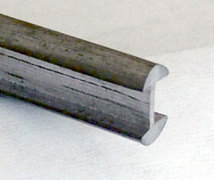Terminology
Leaded glass panels are frequently a combination of flat, textured glass and bevels, all arranged to make a design. The term “leaded” refers to the lead (or brass, or zinc) “CAME” which is the metal which is between each element of the panel’s design. (Some expensive European crystal goblets actually do have lead content in the glass, but that is not what we are talking about here.)
In the typical residential entryway, bevels are the part of the design made from a thicker glass, usually 3/16″ or 1/4″ thick. Bevels have a polished, “cut”, tapered, or faceted, edge that refracts light like a prism, casting rainbows on your entryway’s floor. In most cases, the bevels are clear in color and have no texture at all. You can identify a bevel by the distinctive “break line” where the polished, tapered edge begins, about 1/2″ in from the edge of the piece of glass. You can see a sharp line where the taper or facet begins. Usually the tapered, faceted edge is toward the street in most doors and sidelights.
Some doors (and sidelights) are “Full Beveled”, in that ALL the design elements are beveled. The most common situation is for the panel to have both bevels and flat, textured glass (or glasses). It is not uncommon for a door to have two or three different textures of flat glass along with some bevels.
Flat, textured glass is usually perfectly smooth on one side with a palpable texture on the other. Please see the Common Glasses page for examples of the most common textures. Most of the flat glasses are 1/8″ thick.
 The metal came, whether lead, zinc, or brass, is always soldered together at the joints. The came is shaped like an “H”, with the edges of the glass pieces inside the channels of the “H”. You can tell lead from zinc with a sharp object. Lead is soft and will scratch easily. Brass is obvious by its’ color.
The metal came, whether lead, zinc, or brass, is always soldered together at the joints. The came is shaped like an “H”, with the edges of the glass pieces inside the channels of the “H”. You can tell lead from zinc with a sharp object. Lead is soft and will scratch easily. Brass is obvious by its’ color.
The panels are weatherproofed with a hardening putty which is “grouted” around the edges of each design element which makes the panel rigid and watertight.

